Textile artist. Beck. 23. Pronouns: they/them/theirs. Based in Canada. Links in pinned. Photo by S. Coish, 2022.
Don't wanna be here? Send us removal request.
Text
Visible Mending
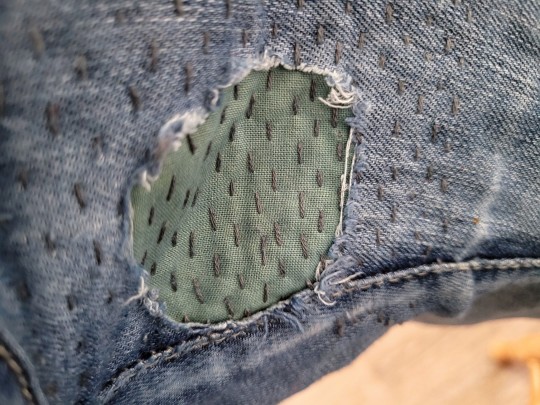

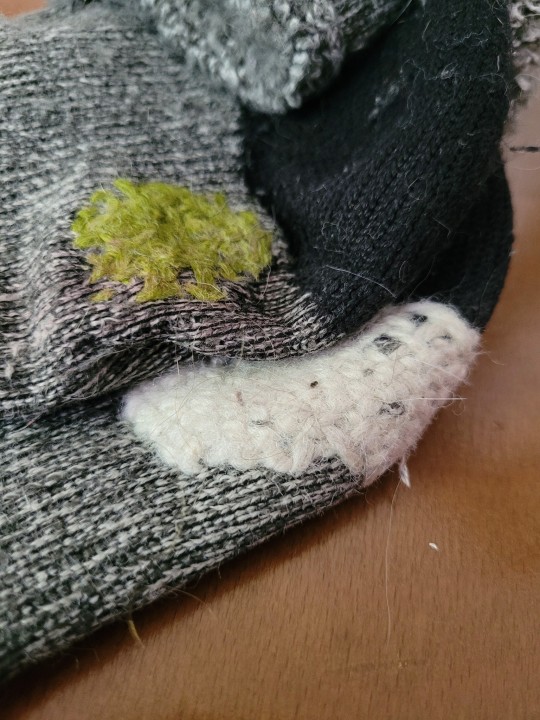
Based in the Japanese art of Sashiko embroidery, visible mending is an art form that embraces the wear and tear on garments, turning them into their own art. Mending is a skill that has gotten a bit lost amongst industrialization and fast fashion, but it’s an incredibly important life skill that is ! It extends the life of your clothes, saves you money, and is a form of self-expression.
Traditional Sashiko is done using running or single stitches in white or blue thread on indigo-dyed fabric, there are many traditional motifs and forms created through the manipulation of the main stitches. While modern Sashiko and visible mending mix colours, patterns, and stitches. Sashiko artists use specific needles and threads on cotton fabric, but visible mending can be done with any needles and threads on any material.
My mending journey started with wool socks, which are expensive these days, but in my opinion are the very best socks for brutal winters. I had several pairs of socks or knit slippers from my late-aunt, which they were the last pieces she made me and so, I taught myself how to mend! To me, mending embraces the history of the garment, the maker, and you, the wearer. Personally, my favourite type of visible mending uses whatever scraps I have in the same colour as the garment stitched using contrast threads, such as the red and black in the second photo. Although, if you want a more subtler mend, the greens and blues of the first photo strike a nice balance.
Links to learn more:
Wada, Yoshiko Iwamoto, “Boro no Bi : Beauty in Humility—Repaired Cotton Rags of Old Japan” (2004). Textile Society of America 9th Biennial Symposium. 458.
Visible Mending - MEND!
Sayraphim Lothian author of Guerilla Kindness and Other Acts of Creative Resistance. (Very good if you are like me and prefer a physical guide).
Caldecott, Sophie. “A Beginner’s Guide to Mending Your Clothing” (2021). Sustainably Chic.
EGA. “Introduction to Visible Mending” (2020). Embroiderers’ Guild of America.
#this is an excellent addition! i totally didn't think to add this note!#mending#visible mending#textile art#textiles#darning
846 notes
·
View notes
Text
“Decomposers and Detritivores”
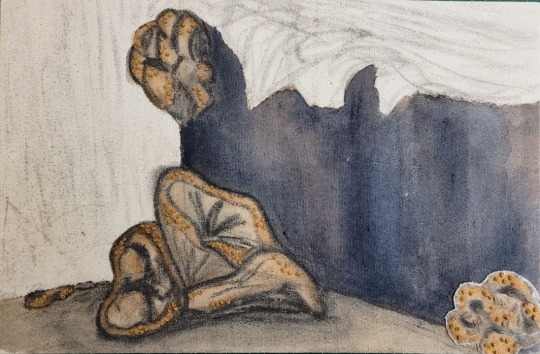

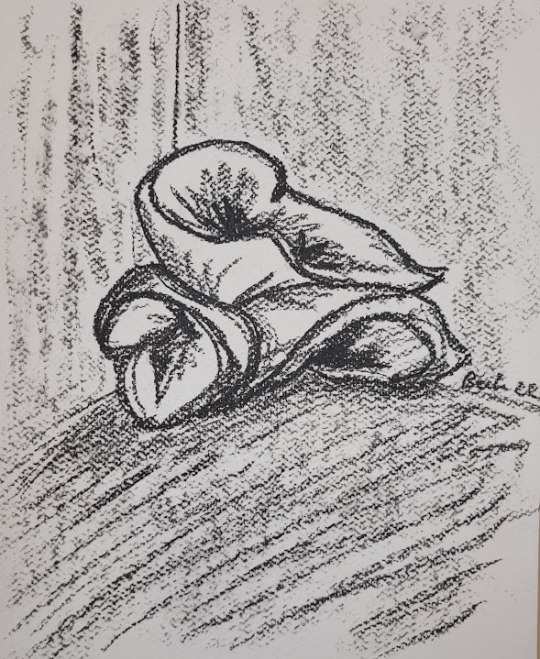
This past year for one of my final projects I combined dyework, drawing, and embroidery. This piece is directly inspired by mushrooms that were growing in a stairwell in my school, fitting with this years pieces that were all inspired by the places that I consider home.
My design process starts with drawing, so it seemed right to highlight that in one of my final pieces, while utilizing natural dyes as paint. I began by compiling my photos of the mushrooms and doing gesture drawings and studies of them in graphite, which is also what I used on the finished piece. The natural dyes I used were bought from Maiwa, including logwood, walnut, and cutch. The piece is entirely silk, the fabric is silk noile that I stretched onto a frame and the embroidery threads are both cultivated silk and silk noile.
(hopefully tumblr doesn’t eat the image quality too much -_-).
#art#disabled artist#textiles#textile art#embroidery#drawing#dyes#natural dyes#natural dye#dyework#mushrooms#silk#silk embroidery#my art
0 notes
Text
Visible Mending



Based in the Japanese art of Sashiko embroidery, visible mending is an art form that embraces the wear and tear on garments, turning them into their own art. Mending is a skill that has gotten a bit lost amongst industrialization and fast fashion, but it's an incredibly important life skill that is ! It extends the life of your clothes, saves you money, and is a form of self-expression.
Traditional Sashiko is done using running or single stitches in white or blue thread on indigo-dyed fabric, there are many traditional motifs and forms created through the manipulation of the main stitches. While modern Sashiko and visible mending mix colours, patterns, and stitches. Sashiko artists use specific needles and threads on cotton fabric, but visible mending can be done with any needles and threads on any material.
My mending journey started with wool socks, which are expensive these days, but in my opinion are the very best socks for brutal winters. I had several pairs of socks or knit slippers from my late-aunt, which they were the last pieces she made me and so, I taught myself how to mend! To me, mending embraces the history of the garment, the maker, and you, the wearer. Personally, my favourite type of visible mending uses whatever scraps I have in the same colour as the garment stitched using contrast threads, such as the red and black in the second photo. Although, if you want a more subtler mend, the greens and blues of the first photo strike a nice balance.
Links to learn more:
Wada, Yoshiko Iwamoto, “Boro no Bi : Beauty in Humility—Repaired Cotton Rags of Old Japan” (2004). Textile Society of America 9th Biennial Symposium. 458.
Visible Mending - MEND!
Sayraphim Lothian author of Guerilla Kindness and Other Acts of Creative Resistance. (Very good if you are like me and prefer a physical guide).
Caldecott, Sophie. “A Beginner’s Guide to Mending Your Clothing” (2021). Sustainably Chic.
EGA. “Introduction to Visible Mending” (2020). Embroiderers’ Guild of America.
#visible mending#mending#disabled artist#embroidery#textile art#textiles#textile artist#art as activism#ecofriendly#environmentalism#ecoconscious#punk#art punk#craftivism#sashiko#sustainability
846 notes
·
View notes
Text
“Compassion is punk rock as hell”

A patch I made a couple years ago in 2019, the pattern is from @shitpostsampler, based on @websurfingspider’s words. I customized and sewed the patch to my denim jacket, and it is one of the very first cross-stitch patches I ever made and still lives on my denim jacket! It's one of the pieces that started my journey using textile art as a form of activism, especially when I was just coming to terms with my disabilities. I was literally using up the last of my aida scraps and ended up having to glue this piece back together, hence the massive line through 'compassion', but that gives it character. This particular patch is very near and dear to me, it served as a reminder to grant myself compassion too.
I and many others have preconceived ideas of what cross-stitch is, I've had people liken it to 'a thing their nan did' or describe it as 'outdated'. When I moved to Newfoundland and Labrador for university, I pushed all my old textile art away, thinking I needed to move towards STEM studies and hobbies (I still don't know what a 'STEM hobby' is). And the more I pursued science the more I ended up coming back to textile art. It came full circle, back to being the thing I did to feel able to breathe again, and eventually, I started the CNA Textile and Apparel Design Program and have graduated!
The two years I spent in university were well-spent, I found amazing friends, learned what I liked and didn't like doing, and I learned that I am absolutely allowed to pursue the things that make me happy. No experience is ever wasted, there is always something to learn and take from every moment! My half of an ecology and environmental science degree has intertwined with my art practice, when it comes to natural dyeing and the pursuit of a more environmentally friendly art practice. The six months I spent working at the Botanical Garden here in the city taught me so much about local plant life and ecology and has served as one of the building blocks of learning more.
#cross stitch#cross stitching#textile art#textiles#textile artist#disabled artist#shitpost sampler#patch#punk#my art#my writing
27 notes
·
View notes
Text
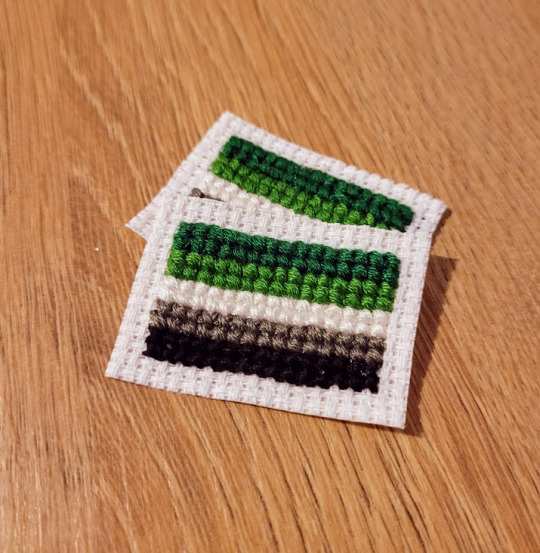


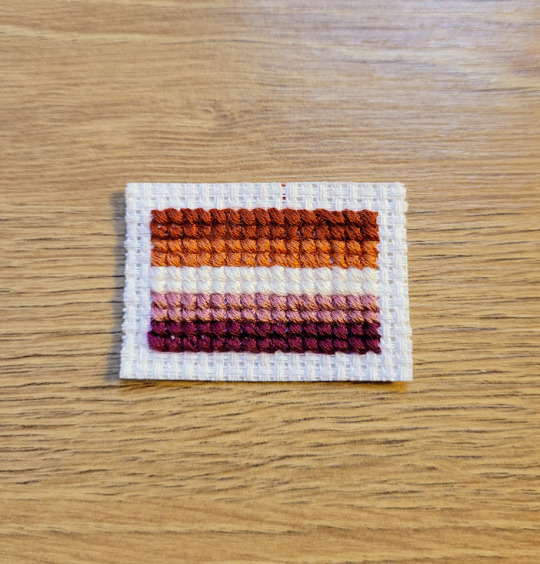
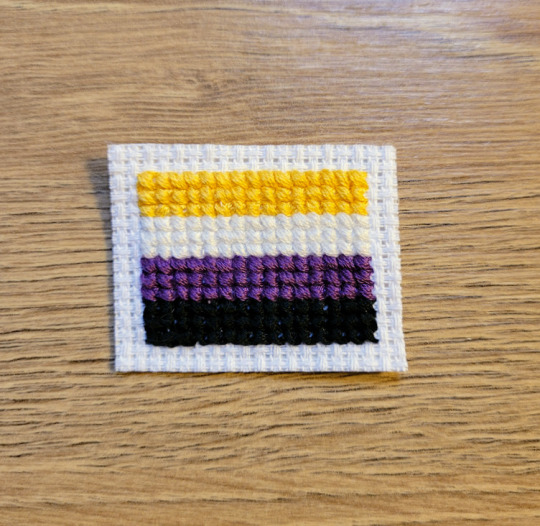

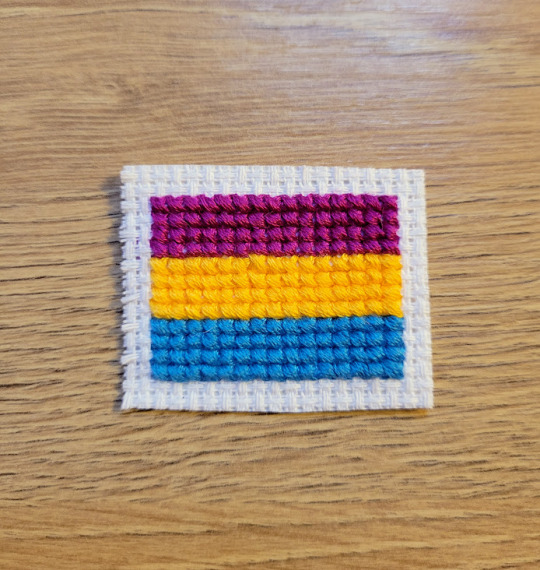

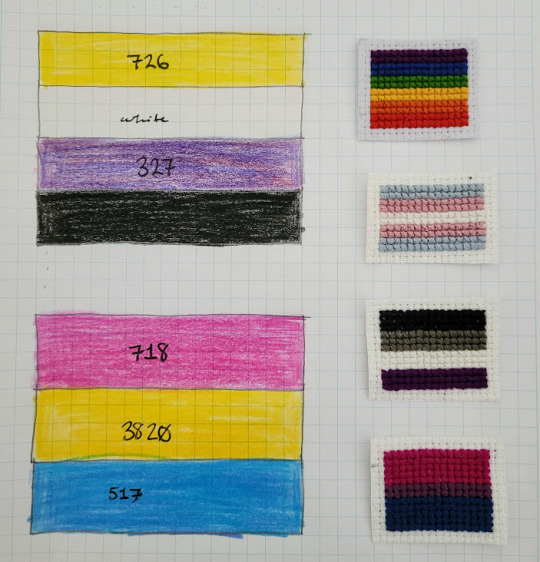
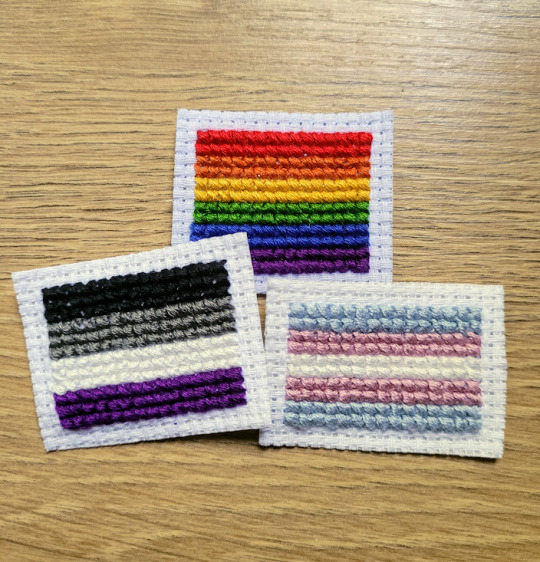
Updated photos of all the pride flag patch variations! If anyone is able to purchase any, it would really help me out this month!
Each patch is handmade by me out of cotton thread and fabric, with iron-on backing. They are $20 each and $22 for a custom design (the extra two dollars are to cover the purchase of materials and the added pattern drafting).
#art#disabled artist#textile art#textile artist#textiles#patch#patches#cross stitch#cross stitching#punk#handcrafted#handmade#pride#pride patches#pride 2022#lgbtq#lgbtq+#asexual#aromantic#bisexual#gay#lesbian#non-binary#pansexual#queer#trans#transgender
156 notes
·
View notes
Text
The pride flag patch listing is up!
Patches are $20 each via Etsy. There is also an option to customize for two extra dollars (that's just to cover the cost of specific thread colours and the bus trip to get them).
Alt text embedded with the photos!
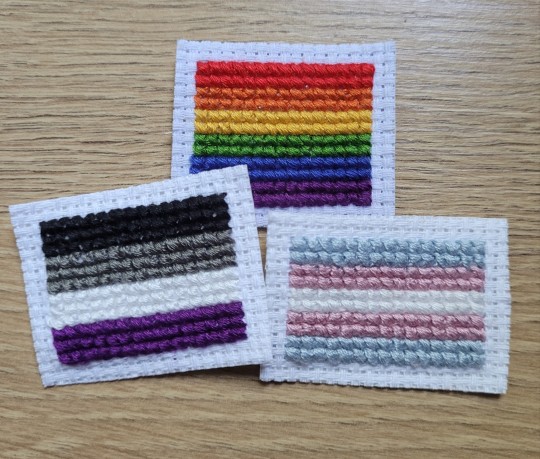

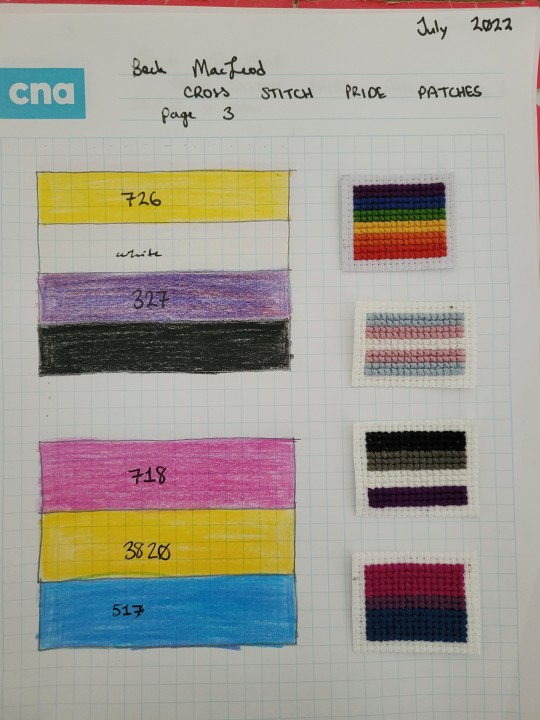
#art#disabled artist#textile art#textile artist#textiles#patch#patches#cross stitch#cross stitching#punk#handcrafted#handmade#pride#pride patches#pride 2022#lgbtq#lgbtq+#asexual#aromantic#bisexual#gay#lesbian#non-binary#pansexual#queer#trans#transgender
19 notes
·
View notes
Text
It's pride month here in Canada and I've been making cross-stitched pride flags! I have the rainbow flag, trans, bisexual, asexual, pansexual, and non-binary flags. Photos of the others coming soon!
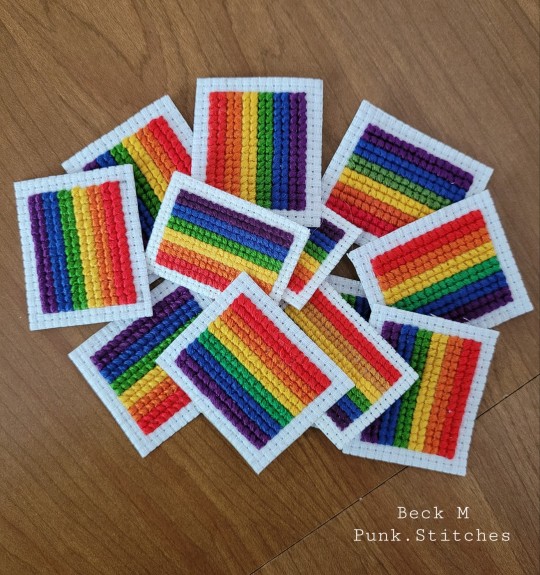
#art#disabled artist#textile art#textile artist#textiles#pride#pride week#pride flag#asexual#bisexual#pansexual#queer#nonbinary#transgender#trans#gay#cross stitch#patches#patch#my art
24 notes
·
View notes
Text
I make and sell these lil bandanas on etsy! The skull motif is handdrawn by me and I freehand embrodier some of the bandanas after printing. Currently they are on sale, 15% off!
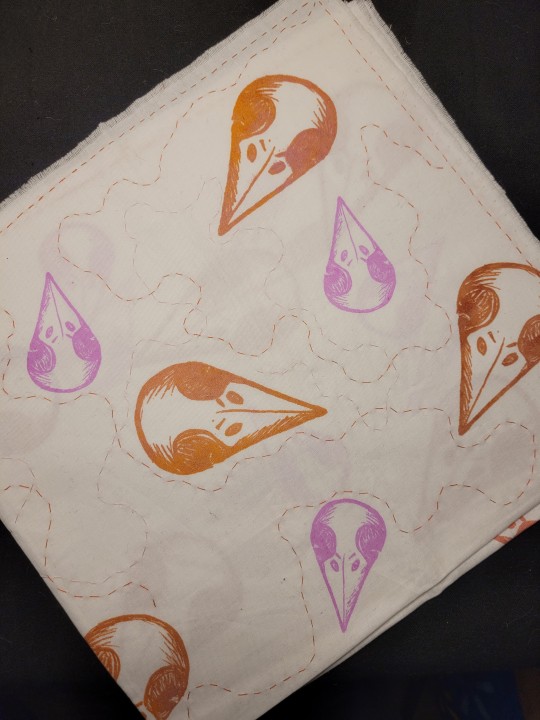

#screenprinting#accessories#apparel#textile art#art#textiles#textile artist#birds#skulls#embroidery#bird skull#corvids#corvid skull#disabled artist#craftblr#my art
8 notes
·
View notes
Text
Hi! I'm Beck and I'm a textile artist based in Canada, the textile mediums I currently focus on are weaving, embrodiery, cross-stitch, knitting, and natural print and dyework. I am a queer, disabled artist and my pronouns are they/them/theirs.
Instagram
Facebook
Etsy
Website
3 notes
·
View notes